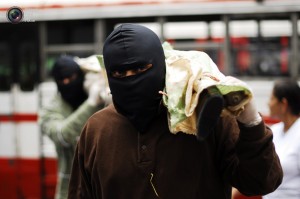By Frederick B. Mills
Council on Hemispheric Affairs
On March 15, 2013, the Salvadoran Minister of Justice and Public Security, David Munguía Payés, held a conversatorio (conversation) with a group of Salvadoran community leaders at the Salvadoran embassy in Washington, D.C.

The main topic was the encouraging reduction of gang related homicides in El Salvador since the inception of a truce between warring gangs in March 2012. The warm reception he received on that day contrasts with earlier skepticism about his appointment in November 2011.
After three decades of failed government attempts at reducing gang related violence, the former defense minister exceeded his commitment to reduce the homicide rate by 30 percent by the end of 2012.
The previous “heavy-handed” approaches to law enforcement (Mano Dura, initiated in 2003, and Super Mano Dura, started in 2004) dramatically increased the number of arrests and incarcerations of alleged offenders, but failed to rein in the gang problem.
So Payés came to his position facing a Salvadoran penal system with overcrowded prisons and a gang culture that had already skillfully adjusted to a series of “get tough” policies.
When President Mauricio Funes made changes to some of his top security appointments in the fall of 2011, gang violence appeared to be intractable while remaining an urgent public concern. It was time to try a new approach.
Payés’s change of course has so far paid off.
Using March 2012 as his benchmark (the start of the gang truce), there has been a reduction of 52.4 percent in the number of homicides committed between March 2011 and December 2011 (3,697 homicides) as compared to the number of murders committed between March 2012 and December 2012 (1,761 homicides).
Moreover, the number of murders has sharply declined from an annual total of 4,371 in 2011 to 2,576 in 2012. Payés has delivered on his promise and then some. So, why does it appear that he is succeeding where so many others have failed?
Payés has given credit for much of the progress in reducing the homicide rate to a partnership between a number of stakeholders, including the church, civilian leaders, and even the heads of the two main gangs.
The minister has indicated that his approach to gang violence has been to treat the issue as two-dimensional—criminal and social. The criminal dimension must be addressed by an enhanced law enforcement capability, which has included the creation of a special police unit in 2012 that specializes in combating gang related crime.
The social dimension, however, should inform the overall approach to the gang problem. Payés explained that, given the roughly 65,000 gang members who have family and friends on the periphery of their activities, there are about 500,000 persons in some way affected by the gang culture.
Payés also drew attention to the socio-economic background and historical conditions that gave rise to gangs in El Salvador. An integral strategy, then, requires an increased investment in prevention and rehabilitation programs as well as job creation. Of course, this will take a lot more resources and a persistent commitment by government and civil society.
The first steps in this new approach to reducing gang violence has led to the establishment of a gang truce; the setting up of violence free zones with the agreement of gang leaders; the cessation of the killing of bus drivers and their cashiers; and the prohibition of gang recruitment near schools.
Despite the progress in some aspects of gang-related crime, gangs have continued to use extortion as a major source of their income. With limited resources, a judicial system in need of reform and overcrowded prisons, Payés acknowledged that the immediate tactics for reducing the killings have been imperfect.
In any case, he has exceeded by more than 20 percent the promised benchmark of reducing the homicide rate in El Salvador.
Payés also answered a number of other security related questions from the floor. For example, Yasmin Romero-Latin, Washington D.C. ANC Commissioner (1D01), said that her son was killed by gang members in El Salvador nine years ago, and asked if the ministry was taking measures to address the psychological and other needs of victims and their families.
She also asked if the ministry was taking effective measures in adjudicating cases of inmates who have been in jail for quite some time. Payés said that the ministry is trying to improve its victim services and that he shares the concern that inmates be adjudicated in a timely manner.
Margarito Esquino, leader of the Associacion Nacional Indigena Salvadorena (ANIS) in the United States, asked the minister if he would look into unresolved crimes committed against indigenous people by security forces in the past. Payés said that once he had all of the information about these cases he would look into this issue.
Payés did not try to paint a rosy picture, despite significant tactical victories. He acknowledged the urgent need for more police training, an increase in resources for both judicial and penal institutions, and to weed out corruption.
Is this trend towards reduced gang violence sustainable?
So far, between January and March 2013, there have been 458 homicides, down 51.7 percent from the previous year. This is indeed a good sign. But more resources for rehabilitation and adjudication, as well as more jobs, are required to transform this into a long term success.
In the meantime, Payés is unapologetic for the gang truce, which he helped engineer and which appears to be holding. “If anyone has a better solution,” Payés said, “let that person put it on the table.”
Frederick B. Mills is Senior Research Fellow at the Council on Hemispheric Affairs




